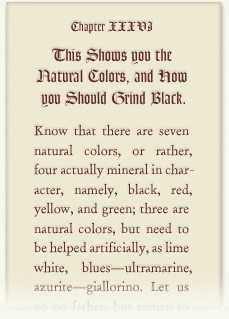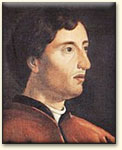Introduction: Early Thoughts by Cennini, Alberti and Chevreul

Excerpt from a modern English translation of the Craftsman’s Handbook (Libro dell’arte) by Cennino Cennini — a treatise marking a transition between medieval and Renaissance concepts of art.
Over the centuries, artists have used the “scientific” understandings of vision and painting to enhance their art.
Over the years, there have been several treatises on the practice, theory and philosophical issues of painting date, and notions about the use of color. The first important Craftsman’s Handbook was written around 1390 by the Tuscan painter Cennino Cennini (c. 1370-1440). Cennini gives explicit instructions on the use of different pigments, how to prepare them, their availability and so forth. Craftsman’s Handbook is an invaluable guide that helps to us understanding early paintings.

Leon Battista Alberti
Over the course of 1435 and 1436, an important treatise was written by the scholar, architect and writer Leon Battista Alberti (1404-1472). Although Alberti was less interested in color, he writes about the value of colors in combination, i.e., the concept that certain colors can enhance each other when juxtaposed. He also discusses the psychological effect of color to arouse emotions in the viewer. These ideas formed part of the science of vision and would be explored by much later writers and artists, and will be discussed in the following pages.

Various pages from Michel Chevreul’s 1839 book, De la Loi du Contraste Simultané des Couleurs.
In 1839, the theory of color interaction was first put on a sound experimental base by the French chemist Michel Chevreul (1786-1889). His De la Loi du Contraste Simultané des Couleurs introduced theories that led to new uses of color. The 19th century also witnessed the Industrial Revolution that made available new technologies such as synthesized pigments, augmenting the artist’s palette. A new scientific worldview searched for to describe experience, including art, light, color and vision, in scientific terms.